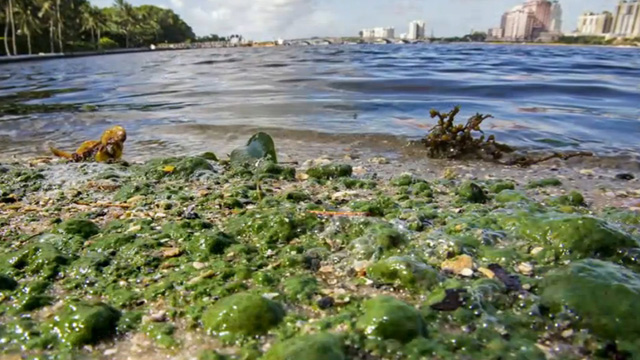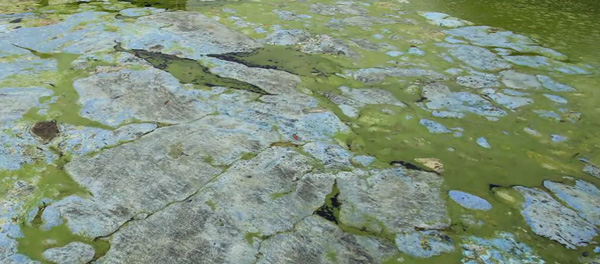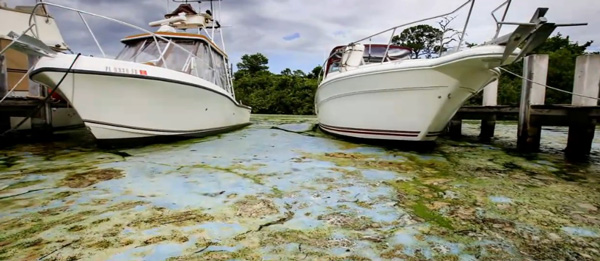Florida beaches invaded by dangerous algae caused by farm fertilizers: respiratory problems, skin rashes and more
Friday, July 08, 2016 by: Wes Maxwell
Tags: toxic algae, biosolids, beaches

(NaturalNews) A state of emergency has been declared in four counties in Florida due to the formation of excessive toxic algae in the state's ocean waters. After having to temporarily shut down a slew of Florida beaches over July 4th weekend because of the presence of algae, the problem has since escalated, and put not just the health of Florida's pristine beaches in peril, but the health of its inhabitants as well.
This "living, putrid green slime" has been reported to make Florida's beaches "smell like a toilet," and has caused a myriad of health issues including headaches, rashes and respiratory issues. The toxic algae first started forming when authorities released water from Lake Okeechobee into a series of canals draining into the ocean two weeks ago.
Lake Okeechobee, like many other lakes in the U.S., has been known for its rampant blooming of dangerous algae. While the mainstream media reports that the algae blooms are being caused by farm fertilizer run-off, evidence suggests another culprit could be to blame.
Sam Shepherd, a chemical engineer with expertise in pathology, told Natural News exclusively that biosolids have been applied near the site of contamination responsible for the dangerous algae.
Biosolids, a treated form of sewage waste combined with toxic waste from various industries, has justifiably been scrutinized for its adverse environmental effects, with land application in Florida being no exception.
Officially classified as a waste material, biosolids are generated when solids accumulated during domestic sewage processing are treated further to meet mandatory regulatory requirements. Essentially the sewage industry's corporate lobbyist term for "sewage sludge", biosolids have been placed in mass quantities around the country since the 1970s.
Lake Okeechobee is no exception. According to Sam Shepherd, "Class B biosolids have been placed around the farmlands of Lake Okeechobee for up to 50 years ... and it will take another 50 years to clean it up."
In light of extensive research in the state of Florida about the environmental and health risks of biosolids, The Overview of DEP's New Biosolids Rule stated that the placement of biosolids in certain designated sites was expected to cease entirely by the year 2013. Interestingly enough, Lake Okeechobee was one of those designated sites. Currently, only about half of such sites have ceased operations.
Although biosolids are treated to pass federal regulations, they more often than not still contain dangerous bacteria and other harmful pathogens. According to Food Safety News, biosolids "regularly tests positive for a host of heavy metals, flame retardants, polycyclic aromatic hydrocarbons, pharmaceuticals, phthalates, dioxins, and a host of other chemicals and organisms."

Photo credit: ABC News

Photo credit: ABC News
Dr. David Lewis, a former EPA scientist, reported directly to Natural News that some of the known human health effects of biosolid exposure include: shortness of breath, mucus in the lungs, skin rashes and other respiratory issues. Coincidentally, many of the aforementioned symptoms are not too dissimilar to the symptoms experienced by those exposed to the algae blooming on Florida's beaches.
Additionally, Dr. David Lewis's book, Science For Sale, links biosolids to increases in antibiotic resistance, perhaps providing a cause for ABC News' reports of serious infections afflicting Florida inhabitants exposed to the ocean's algae outbreak.
Furthermore, Newsweek reported earlier this year that the presence of biosolids in livestock grazing pastures has the potential to cause grave human health-related consequences. "Given that these chemicals are very persistent," Richard Lea, a reproductive biologist at the School of Veterinary Medicine and Science at the University of Nottingham, wrote, "and they've survived the very intensive processing of the sewage to begin with, there's a very high chance they'll end up inside us."
No one knows exactly what happens to the leftover contaminants in biosolids once they are placed into soil, but there is more and more evidence suggesting it cannot be good. To uncover the truth about exactly how detrimental biosolids are to human health, calls for independent lab testings are crucially important. Whether biosolids are the cause of Florida beaches' toxic algae problem remains to be seen for certain, but the dots continue to line up, and Florida's beaches continue to look like ghost towns. Check back for updates.
Sources:
Hindawi.com
ABCNews.Go.com
FoodSafetyNews.com
Dep.State.FL.US[PDF]
Amazon.com
Europe.NewsWeek.com
Toxic algae at FETCH.news
Get independent news alerts on natural cures, food lab tests, cannabis medicine, science, robotics, drones, privacy and more.
Take Action: Support Natural News by linking to this article from your website
Permalink to this article:
Embed article link: (copy HTML code below):
Reprinting this article:
Non-commercial use OK, cite NaturalNews.com with clickable link.
Follow Natural News on Facebook, Twitter, Google Plus, and Pinterest
- “Sudden death” COVID vaccine paper published, then censored, by The Lancet now republished with peer review
- Dark secrets exposed: CIA is behind Deagel’s shocking 2025 depopulation forecast & official excess death figures in the millions prove it’s on target & not just an estimation
- Top emergency water storage tips for preppers
- Federal court filing exposes MAJOR FRAUD in “sale of Infowars to The Onion
- Trump confirms a national emergency is coming so he can carry out mass deportations with the help of the U.S. military
- "Disinformation Dozen" smear campaign authors at the CCDH are now under investigation by Congress
- Susie Wiles, Trump’s pick for chief of staff, ran P.R. campaigns for GAVI, the Vaccine Alliance, Gilead, Pfizer, and long list of globalist companies
- Southwest Airlines jet hit with GUNFIRE at Dallas Love Field Airport in bizarre shooting
- Vaccine stocks plummet after RFK Jr. nominated as HHS secretary
- Elon Musk’s X dips its fingers into InfoWars’ bankruptcy case
- Clearly staged “neo-Nazi” march through Columbus, Ohio, aims to catalyze more antisemitism speech laws
- Donald Trump names John Ratcliffe as CIA director
- Mike Huckabee, Trump’s pick for U.S. ambassador to Israel, believes “there’s no such thing as a Palestinian”
- China’s new hypersonic weapon could tip the scales in future conflicts in Taiwan and the South China Sea
- Tarragon: Versatile ancient herb with science-backed health benefits
- Scientific American editor resigns following her social media posts criticizing Trump supporters as “fascists” and “bigoted”
- Trump names Tulsi Gabbard to be the next Director of National Intelligence
- German military readying for NEW WAR with Russia, classified document reveals
- New Zealand cardiologists concede the simple truth: Spike protein generated by mRNA COVID vaccines is a CARDIOTOXIN
- RFK Jr. says Bill Gates, Fauci will both be arrested under Trump
- Dutch health minister admits that COVID-19 was a "military operation" involving NATO
- Natural News announces list of most important objectives RFK, Jr. must consider as head of HHS
- Opposition to vaccines constitutes “antisemitism and the targeting of Jewish biomedical sciences at its core,” claims Jerusalem Post
- Chinese drone maker DJI sues Defense Department over inclusion in ChiCom military company list
- Trump releases “single most important video on the internet today” about how to rid world of deep state tyranny
- The forgotten holocaust: 20 million Christians SLAUGHTERED by Bolsheviks of former Soviet Union, many of whom were JEWS
- Fed pulls half of credit available from BTFP, engineering a potential banking crash to be thrown in Trump’s lap
- Pharmaceutical narratives surrounding the "flu" are based on fraud and are primarily designed to sell worthless vaccines
- Spain cancels $6.48M arms deal with Israeli defense company amid ongoing IDF violence inflicted upon Gazans
- The history of the House of Rothschild
- Biden urges Ukraine to hit North Korean troops that its military encounters on the battlefield
- POLL: Trump takes narrow lead against Harris in Pennsylvania
- White House legalizes all gain-of-function research to build more BIOWEAPONS
- CBP officer sentenced to 23 years in jail for BRIBERY and facilitating TRAFFICKING
- Newly elected Canadian Liberal premier vows to expand abortion access in her province as soon she is sworn into office
- The government is not going to ride in on a white horse to save you when global events hit the fan
- ANALYSIS: Trump is going to win BIG, and then the real fireworks begin… America won’t survive as we know it for even ONE YEAR
- The history of the House of Rothschild
- Opposition to vaccines constitutes “antisemitism and the targeting of Jewish biomedical sciences at its core,” claims Jerusalem Post
- Top 12 NEW "SYNDROMES" created by insidious government forces, Big Pharma and their propaganda-purporting media complex
- The ugly, horrifying history of Israel’s military, the “most moral army in the world”
- White House legalizes all gain-of-function research to build more BIOWEAPONS
- The forgotten holocaust: 20 million Christians SLAUGHTERED by Bolsheviks of former Soviet Union, many of whom were JEWS
- Pharmaceutical narratives surrounding the "flu" are based on fraud and are primarily designed to sell worthless vaccines
- Hysterical, power-hungry EPA will require all property owners to have "no detectable level of lead dust in the air" - an impossible feat
- JOE ROGAN interviews TRUMP: The likely next POTUS directly addresses NUTRITION and HEALTH
- Israel claims there are secret tunnels filled with gold under Lebanese hospital - but it’s all a hoax to justify bombing civilian infrastructure
- Pfizer knew about serious adverse events linked to COVID-19 vaccines but pushed the jabs on the world anyway
- Chinese drone maker DJI sues Defense Department over inclusion in ChiCom military company list
- Trump vows no more foreign wars - Kamala, he says, will “gamble with the lives of millions”
- Major election forecasters predict a decisive victory for Trump
- South Africa files 750 pages of evidence against Israel in ICJ genocide case
- POLL: Trump takes narrow lead against Harris in Pennsylvania
- Russia has invoked Article 4 of its mutual defense treaty with North Korea, Putin confirms
- Red Cross issues warning to stop blood plasma donations from vaccinated people
- Heavily CENSORED Pfizer documents show that COVID began a five-year mass DEPOPULATION agenda that will reach completion by 2025
- DATA: England’s vaccinated population had close to one million deaths in 23 months; unvaccinated population had less than 61,000 deaths over the same period
- Scientists confirm: GENIUS brain function can be spontaneously unleashed in humans without any apparent cause
- Arizona residents drive entire Maricopa County Board of Supervisors out of meeting after serving them for TREASON
- Anonymous airline pilot exposes chemtrail operation in the U.K.
- People who got COVID jabbed now displaying major personality changes stemming from vaccine-induced neurological damage, experts warn
- Today I asked our AI language model “Neo” about which phytonutrients or phytochemicals can block the spike protein related to SARS-CoV-2 … Here is what it answered…
- Fully vaccinated about to see “tsunami” of illness and death, warns virologist
- Study: TikTok trend of hotwiring certain car models linked to surge in car thefts in U.S. cities
- Full-scale medical martial law coming to America in 2024
- 5G REMOTE KILL VECTOR: Science paper reveals cell phone signals can activate the release of biological PAYLOADS from graphene oxide injected into the body
- BREAKING: 2025 NDAA authorizes mandatory military draft of WOMEN across America… as Pentagon pursues global NUCLEAR war with both Russia and China at the same time
- Former Bill Gates vaccine scientist predicts sharp population decline: “up to 30-40% in highly vaccinated countries”
- We are building the infrastructure of human freedom… Brighteon.AI is the next launch that will put life-altering LLM technology into your hands for free
- NASA admits that climate change occurs because of changes in Earth’s solar orbit, and NOT because of SUVs and fossil fuels
- ENGINEERED FAMINE: Oregon starts SHUTTING DOWN small farms “to protect the people”
- These 13 countries just signed an agreement to engineer a global FAMINE by destroying food supply
Science News & Studies
Medicine News and Information
Food News & Studies
Health News & Studies
Herbs News & Information
Pollution News & Studies
Cancer News & Studies
Climate News & Studies
Survival News & Information
Gear News & Information
News covering technology, stocks, hackers, and more



"Big Tech and mainstream media are constantly trying to silence the independent voices that dare to bring you the truth about toxic food ingredients, dangerous medications and the failed, fraudulent science of the profit-driven medical establishment.
Email is one of the best ways to make sure you stay informed, without the censorship of the tech giants (Google, Apple, Facebook, Twitter, YouTube, etc.). Stay informed and you'll even likely learn information that may help save your own life."
–The Health Ranger, Mike Adams























